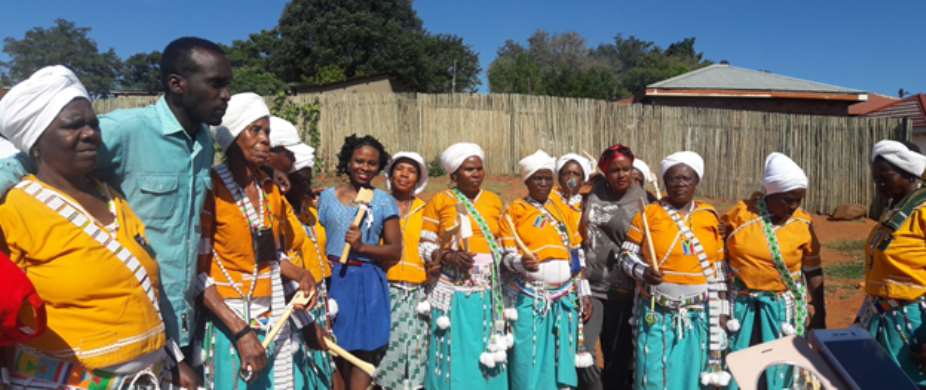A visit to one of South Africa’s most well maintained cultural sites, the Modjadji Royal Kraal, brings to life a tale of the only matrilineal dynasty in the country. Surrounded by the exquisitely green Wolkberg Mountains North of Tzaneen, in Limpopo Province, sits the majestic village that is home to the Balobedu tribe of the Rain Making Queen.
A group of traditional women dancers are a delightful welcome to the royal homestead, donned in traditional beaded attire that gaudily crowns their melodic voices accompanied by the sounds of traditional drums.
As we swiftly internalize the rhythms, it is almost difficult to not join in the dance; though a bit difficult to match the well-defined movements that the dancers have mastered over the years. Notably, is the “shoes-off” custom that we all must conform to, as they are traditionally forbidden in the Kraal. As the dances fade in the background, Moshakge Molokwane, the Secretary to the Balobedu Royal Council and our guide of the Kraal, charmingly narrates the tale behind the existence of his people ; and the only traditional ruling queen that is of incest, contention and a mystical history dating back four centuries ago.
Today, the Balobedu people maintain most of the culture, including the position of the Modjadji Queenship who is the leader of the tribe, and the rain making traditional ceremony that is marked every first week of October. While some of the traditions are outdated and eroded by Westernization as well as religion, Molokwane still believes in the powers of his Rain Queen. “I am a teacher by profession and aware of modern-day challenges such as globalization and climate change, but that has not affected my beliefs, nor that of my people, in the powers of our Rain Making Queen.”
Such a strong composition and maintenance of historical heritage as is of the Balobedu people is to be honored. The Kraal has over the years contributed massively to the South African tourism. It attracts thousands of cultural tourists every year, who seek to unravel a tradition so deep-rooted and mystical in the middle of an African civilization.
After an interactive time with the homesteaders, we hike the hill to the neighboring Modjadji Cycad Reserve, the largest concentration of a single cycad species in the world. The species, also known as the Modjadji Cycad, forms an unspoiled and unique natural forest, which is part of the empire ruled by the legendary Rain Queen. The rings around each cycad can interpret its age, and their enormous cones are a view to bestow.

Modjadji Cycad Reserve
It is here, under the ancient thatched canopies that we are offered a selection of traditional foods for lunch, among them South Africa’s famous pap and Chakalaka. A scrumptious meal with a view of the misty cycad valley, gives an invigorating urge to retain cultural heritage; if only to give our future generation a chance to experience the same sensation. As we head back to Protea Ranch Hotel Resort , where a group of African journalists were being hosted for a media tour of South Africa’s Limpopo Province, one could only look forward to another visit of more cultural sites that remind us of our African story. The media tour, organized by South African Tourism, is an initiative that aims to facilitate African media to promote tourism within the continent.
Credit: Josephine Wawira





 We’ll no longer tolerate your empty, unwarranted attacks – TUC blasts Prof Adei
We’ll no longer tolerate your empty, unwarranted attacks – TUC blasts Prof Adei
 Bawumia donates GHc200,000 to support Madina fire victims
Bawumia donates GHc200,000 to support Madina fire victims
 IMF to disburse US$360million third tranche to Ghana without creditors MoU
IMF to disburse US$360million third tranche to Ghana without creditors MoU
 Truck owner share insights into train collision incident
Truck owner share insights into train collision incident
 Paramount chief of Bassare Traditional Area passes on
Paramount chief of Bassare Traditional Area passes on
 Two teachers in court over alleged illegal possession of BECE papers
Two teachers in court over alleged illegal possession of BECE papers
 Sunyani: Victim allegedly shot by traditional warriors appeals for justice
Sunyani: Victim allegedly shot by traditional warriors appeals for justice
 Mahama vows to scrap teacher licensure exams, review Free SHS policy
Mahama vows to scrap teacher licensure exams, review Free SHS policy
 Government will replace burnt Madina shops with a new three-story, 120-store fac...
Government will replace burnt Madina shops with a new three-story, 120-store fac...
